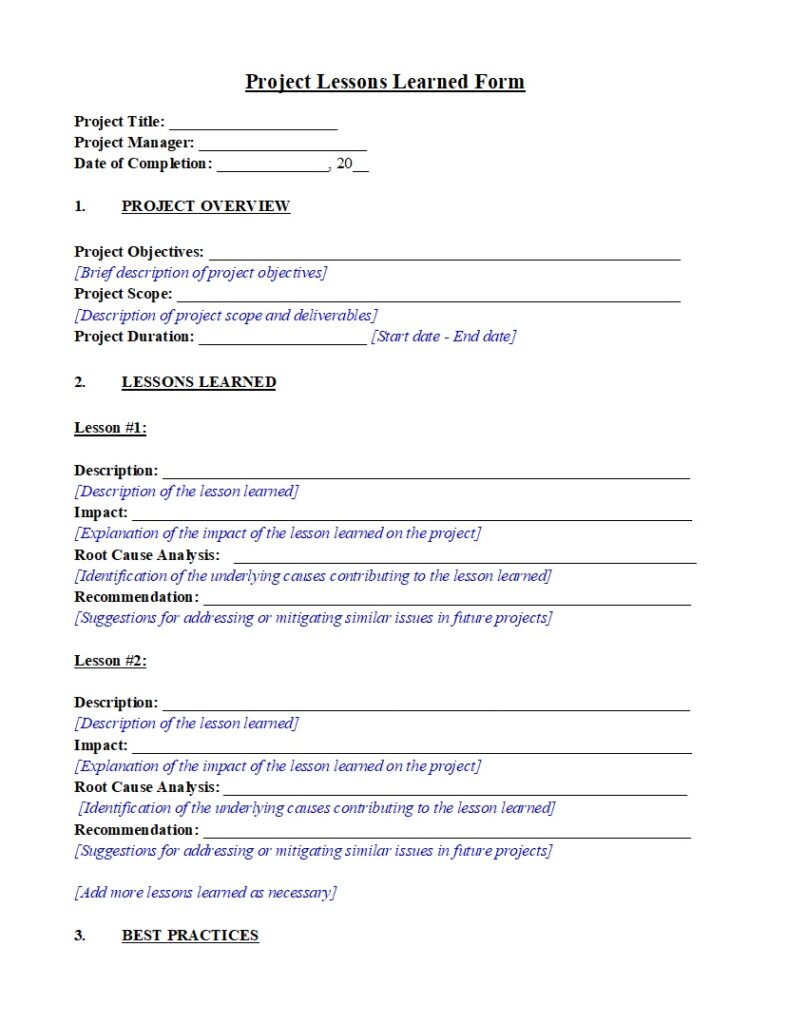Estimated reading time: 3 minutes
Purpose and Importance
A Lessons Learned Form is a structured tool that allows project teams to record insights, experiences, and practical recommendations obtained during or after the completion of a project. It is not merely a reporting form—it acts as a bridge between past experiences and future performance, ensuring that valuable lessons are captured systematically rather than forgotten over time. By analyzing what worked well and what did not, organizations strengthen their internal knowledge base and improve project delivery efficiency.

Structure and Components
A well-designed Lessons Learned Form typically includes sections such as project details, objectives achieved, issues encountered, root cause analysis, corrective actions, and suggested improvements. These components create a consistent framework that allows teams to document both successes and shortcomings clearly. The process of completing the form encourages honest reflection, cross-functional dialogue, and the identification of practical measures for process refinement.
Application and Benefits
Using the Lessons Learned Form promotes transparency and accountability within the project environment. It enables project managers, sponsors, and stakeholders to make data-driven adjustments to methodologies.
Application and Benefits
Using the Lessons Learned Form promotes transparency and accountability within and strategies in future projects. By systematically collecting feedback, teams can recognize recurring patterns, mitigate risks, and replicate successful practices. This proactive learning process minimizes repetition of past mistakes and supports informed decision-making at every project stage. Moreover, it aligns with organizational objectives for quality assurance, governance, and operational excellence.
Integration into Project Lifecycle
The Lessons Learned Form should not be treated as a post-project formality; instead, it must be integrated throughout the project lifecycle. Capturing lessons during key milestones—initiation, planning, execution, and closure—ensures timely insights while events are still fresh in memory. This approach transforms lessons learned into a continuous improvement mechanism rather than a retrospective exercise. Organizations that embed this process within their project management framework establish a culture of ongoing learning, adaptability, and resilience.
Organizational Impact
When consistently applied, the Lessons Learned Form becomes a cornerstone of organizational knowledge management. It encourages collective wisdom, supports training programs, and informs future project methodologies. As repositories of experience expand, companies can create internal databases of best practices that serve as strategic assets. The form thus evolves from a simple documentation tool into a dynamic resource fostering innovation, collaboration, and long-term project success.
References
- A Guide to the Project Management Body of Knowledge (PMBOK® Guide) – Seventh Edition (2021) by the Project Management Institute.
- The Handbook of Project Management – 6th Edition (2024) edited by Martina Huemann & Rodney Turner.
- APM Body of Knowledge — Association for Project Management: Article on “What is knowledge management?” discusses use of lessons-learned in KM..
Related Topics:
#ProjectManagement #LessonsLearned #ContinuousImprovement #KnowledgeManagement #PMBOK #OrganizationalLearning #ProjectLifecycle #InnovationCulture
has been added to your cart!
have been added to your cart!



